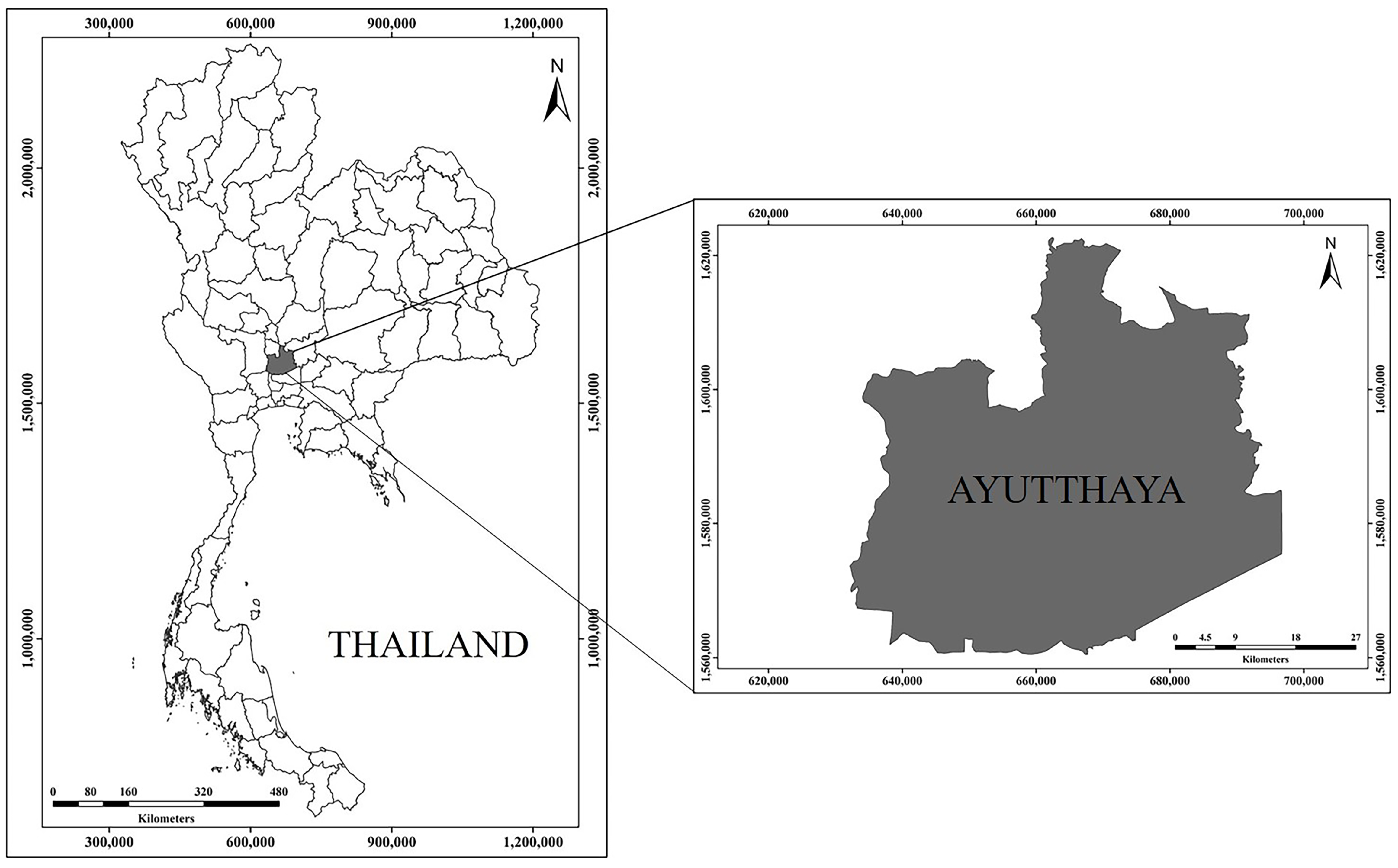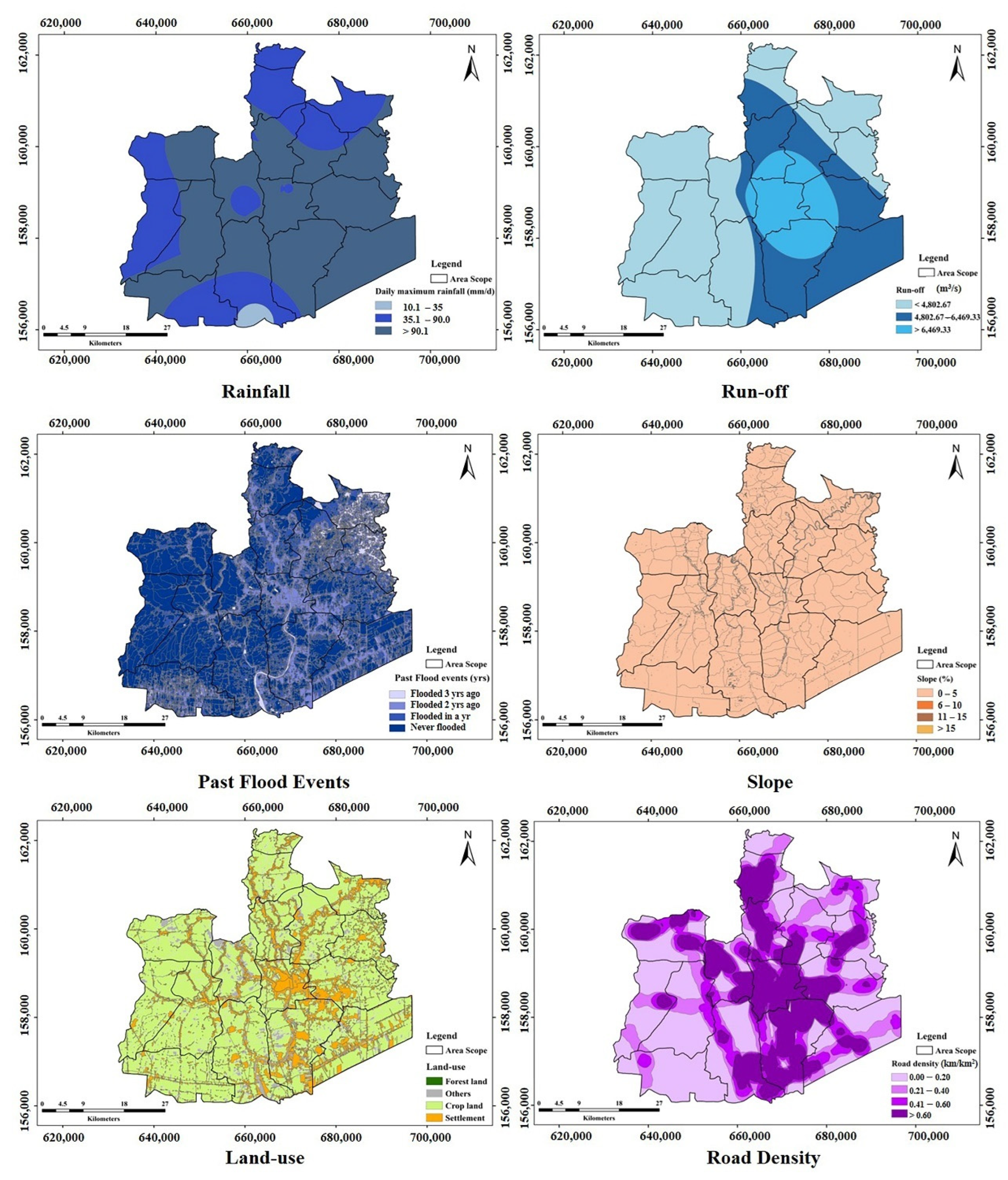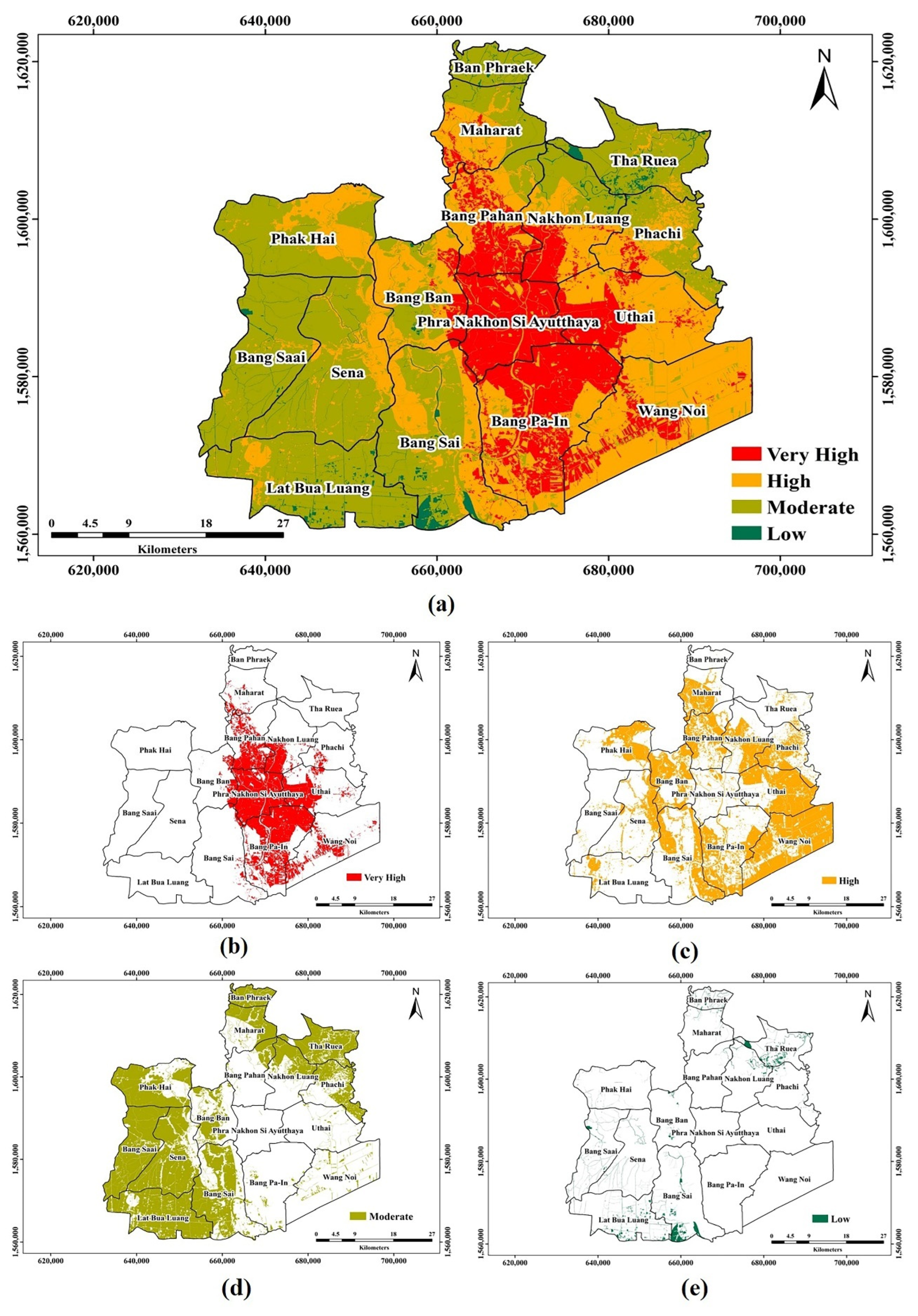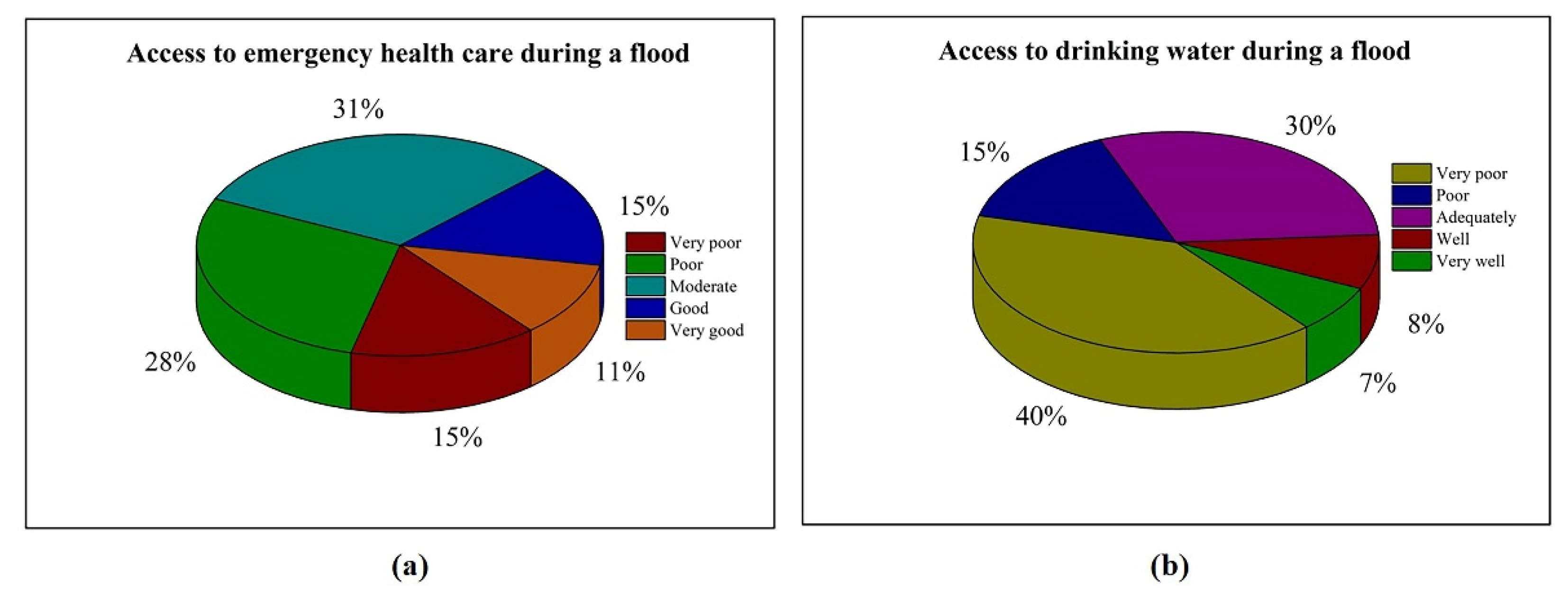Climatic and Hydrological Factors Affecting the Assessment of Flood Hazards and Resilience Using Modified UNDRR Indicators: Ayutthaya, Thailand
Abstract
1. Introduction
2. Literature Review and Research Objectives
2.1. Factors Affecting Flood Hazard Assessment
2.2. Flood Resilience Assessment
2.3. Research Objectives
3. Materials and Methods
3.1. Case Study Selection
3.2. Assessment of Flood Hazard Mapping and Resilience
3.3. Survey and Data Analysis: Flood Management Strategies and Preparation
4. Results
4.1. AHP-GIS Flood Risk Mapping
4.2. Community Flood Management Strategies and Actions for Preparation
4.3. Access to and Availability of Basic Urban Services
4.4. Flood Resilience Assessment Based on the Modified UNDRR Indicators
5. Discussion
5.1. Flood Hazard Mapping and Climatic and Hydrological Factors
5.2. Flood Resilience Assessment
5.3. Implications and Recommendations
6. Conclusions
Supplementary Materials
Author Contributions
Funding
Institutional Review Board Statement
Acknowledgments
Conflicts of Interest
References
- Pinos, J.; Quesada-Román, A. Flood risk-related research trends in Latin America and the Caribbean. Water 2022, 14, 10. [Google Scholar] [CrossRef]
- Quesada-Román, A. Flood risk index development at the municipal level in Costa Rica: A methodological framework. Environ. Sci. Policy 2022, 133, 98–106. [Google Scholar] [CrossRef]
- European Commission. INFORM Index for Risk Management. Thailand Country Profile. 2019. Available online: https://drmkc.jrc.ec.europa.eu/inform-index/INFORM-Risk/Country-Profile/moduleId/1767/id/386/controller/Admin/action/CountryProfile (accessed on 4 January 2022).
- AHA Centre. ASEAN Risk Monitor and Disaster Management Review (ARMOR); ASEAN Coordinating Centre for Humanitarian Assistance on Disaster Management (AHA Centre): Jakarta, Indonesia, 2018. [Google Scholar]
- Shi, P.; Kasperson, R. World Atlas of Natural Disaster Risk; IHDP/Future Earth-Integrated Risk Governance Project Series; Springer: Berlin/Heidelberg, Germany, 2015. [Google Scholar] [CrossRef]
- The World Bank Group and the Asian Development Bank. Climate Risk Country Profile: Thailand. 2021. Available online: https://reliefweb.int/sites/reliefweb.int/files/resources/climate-risk-country-profile-thailand.pdf (accessed on 17 March 2022).
- UNISDR. Prevention Web: Basic Country Statistics and Indicators. 2014. Available online: https://www.preventionweb.net/countries (accessed on 4 April 2022).
- Komori, D.; Nakamura, S.; Kiguchi, M.; Nishijima, A.; Yamazaki, D.; Suzuki, S.; Kawasaki, A.; Oki, K. Characteristics of the 2011 Chao Phraya River flood in Central Thailand. Hydrol. Res. Lett. 2012, 6, 41–46. [Google Scholar] [CrossRef]
- Perwaiz, A. Thailand floods and impact on private sector. In Disaster Management and Private Sectors; Springer: Tokyo, Japan, 2015; pp. 231–245. [Google Scholar]
- UNISDR. Hyogo Framework for Action 2005–2015: Building the Resilience of Nations and Communities to Disasters; A/CONF.206/6. UNISD; World Conference on Disaster Reduction: Kobe, Japan, 2005. [Google Scholar]
- Quesada-Román, A.; Villalobos-Portilla, E.; Campos-Durán, D. Hydrometeorological disasters in urban areas of Costa Rica, Central America. Environ. Hazards 2020, 20, 264–278. [Google Scholar] [CrossRef]
- Sharifi, A. Resilient urban forms: A macro-scale analysis. Cities 2019, 85, 1–14. [Google Scholar] [CrossRef]
- UNDRR. Making Cities Resilient 2030. 2021. Available online: https://www.unisdr.org/campaign/resilientcities/home/article/making-cities-resilient-2030-mcr2030-initial-proposal.html (accessed on 20 November 2021).
- Dung, N.B.; Long, N.Q.; Goyal, R.; An, D.T.; Minh, D.T. The Role of Factors Affecting Flood Hazard Zoning Using Analytical Hierarchy Process: A Review. Earth Syst. Environ. 2021, 5. [Google Scholar] [CrossRef]
- Tang, J.; Li, Y.; Cui, S.; Xu, L.; Hu, Y.; Ding, S.; Nitivattananon, V. Analyzing the spatiotemporal dynamics of flood risk and its driving factors in a coastal watershed of southeastern China. Ecol. Indic. 2021, 121, 107134. [Google Scholar] [CrossRef]
- Joo, H.; Choi, C.; Kim, J.; Kim, D.; Kim, S.; Kim, H.S. A Bayesian Network-Based Integrated for Flood Risk Assessment (InFRA). Sustainability 2019, 11, 3733. [Google Scholar] [CrossRef]
- Xu, H.; Ma, C.; Lian, J.; Xu, K.; Chaima, E. Urban flooding risk assessment based on an integrated k-means cluster algorithm and improved entropy weight method in the region of Haikou, China. J. Hydrol. 2018, 563, 975–986. [Google Scholar] [CrossRef]
- Jato-Espino, D.; Lobo, A.; Ascorbe-Salcedo, A. Urban flood risk mapping using an optimised additive weighting methodology based on open data. J. Flood Risk Manag. 2019, 12, e12533. [Google Scholar] [CrossRef]
- Zhao, G.; Pang, B.; Xu, Z.; Peng, D.; Xu, L. Assessment of urban flood susceptibility using semi-supervised machine learning model. Sci. Total Environ. 2018, 659, 940–949. [Google Scholar] [CrossRef] [PubMed]
- Chen, A.S.; Evans, B.; Djordjevi, S.; Savi, D.A. Multi-layered coarse grid modelling in 2D urban flood simulations. J. Hydrol. 2012, 470–471, 1–11. [Google Scholar] [CrossRef]
- Zhang, S.; Pan, B. An urban storm-inundation simulation method based on GIS. J. Hydrol. 2014, 517, 260–268. [Google Scholar] [CrossRef]
- Darabi, H.; Choubin, B.; Rahmati, O.; Torabi Haghighi, A.; Pradhan, B.; Kløve, B. Urban flood risk mapping using the GARP and QUEST models: A comparative study of machine learning techniques. J. Hydrol. 2019, 569, 142–154. [Google Scholar] [CrossRef]
- Pourghasemi, H.R.; Razavi-Termeh, S.V.; Kariminejad, N.; Hong, H.; Chen, W. An assessment of metaheuristic approaches for flood assessment. J. Hydrol. 2020, 582, 124536. [Google Scholar] [CrossRef]
- Goodarzi, L.; Banihabib, M.E.; Roozbahani, A. A decision-making model for flood warning system based on ensemble forecasts. J. Hydrol. 2019, 573, 207–219. [Google Scholar] [CrossRef]
- Huang, S.; Wang, H.; Xu, Y.; She, J.; Huang, J. Key disaster-causing factors chains on urban flood risk based on bayesian network. Land 2021, 10, 210. [Google Scholar] [CrossRef]
- Saaty, T.L. Decision making with the analytic hierarchy process. Int. J. Serv. Sci. 2008, 1, 83–98. [Google Scholar] [CrossRef]
- Ikram, M.; Zhang, Q.; Sroufe, R. Developing integrated management systems using an AHP-Fuzzy VIKOR approach. Bus. Strategy Environ. 2020, 29, 2265–2283. [Google Scholar] [CrossRef]
- De Brito, M.M.; Evers, M. Multi-criteria decision-making for flood risk management: A survey of the current state of the art. Nat. Hazards Earth Syst. Sci. 2016, 16, 1019–1033. [Google Scholar] [CrossRef]
- Kittipongvises, S.; Phetrak, A.; Rattanapun, P.; Brundiers, K.; Buizer, J.L.; Melnick, R. AHP-GIS analysis for flood hazard assessment of the communities nearby the world heritage site on Ayutthaya Island, Thailand. Int. J. Disaster Risk Reduct. 2020, 48, 101612. [Google Scholar] [CrossRef]
- Sawangnate, C.; Chaisri, B.; Kittipongvises, S. Flood hazard mapping and flood preparedness literacy of the elderly population residing in Bangkok, Thailand. Water 2022, 14, 1268. [Google Scholar] [CrossRef]
- Li, J.; Chen, H.; Liu, Z.; Zou, C. Integrated GIS/AHP-based flood disaster risk assessment and zonation: A case study of Henan Province, China. Proc. SPIE 2010, 7824, 428–438. [Google Scholar]
- Danumah, J.H.; Odai, S.N.; Saley, B.M.; Szarzynski, J.; Thiel, M.; Kwaku, A.; Kouame, F.K.; Akpa, L.Y. Flood risk assessment and mapping in Abidjan district using multi-criteria analysis (AHP) model and geoinformation techniques, (cote d’ivoire). Geoenviron. Disasters 2016, 3, 10. [Google Scholar] [CrossRef]
- Radwan, F.; Alazba, A.A.; Mossad, A. Flood risk assessment and mapping using AHP in arid and semiarid regions. Acta Geophys. 2019, 67, 215–229. [Google Scholar] [CrossRef]
- Hämmerling, M.; Kałuza, T.; Zawadzki, P.; Zaborowski, S.; Sojka, M.; Liberacki, D.; Ptak, M. Application of Multi-Criteria Analytic Methods in the Assessment of the Technical Conditions of Small Hydraulic Structures. Buildings 2022, 12, 115. [Google Scholar] [CrossRef]
- Oladokun, V.O.; Montz, B.E. Towards measuring resilience of flood-prone communities: A conceptual framework. Nat. Hazards Earth Syst. Sci. 2019, 19, 1151–1165. [Google Scholar] [CrossRef]
- Campbell, K.A.; Laurien, F.; Czajkowski, J.; Keating, A.; Hochrainer-Stigler, S.; Montgomery, M. First insights from the Flood Resilience Measurement Tool: A large-scale community flood resilience analysis. Int. J. Disaster Risk Reduct. 2019, 40, 101257. [Google Scholar] [CrossRef]
- Moghadas, M.; Asadzadeh, A.; Vafeidis, A.; Fekete, A.; Kötter, T. A multi-criteria approach for assessing urban flood resilience in Tehran. Iran. Int. J. Disaster Risk Reduct. 2019, 35, 101069. [Google Scholar] [CrossRef]
- Shrestha, S. Assessment of water availability under climate change scenarios in Thailand. In Climate Change Impacts and Adaptation in Water Resources and Water Use Sectors; Springer: Berlin/Heidelberg, Germany, 2014; pp. 9–23. [Google Scholar]
- Ministry of Finance and World Bank. Thailand Flooding 2554: Rapid Assessment for Resilient Recovery and Reconstruction Planning. 2012. Available online: http://www.undp.org/content/dam/thailand/docs/UNDP_RRR_THFloods.pdf (accessed on 17 March 2021).
- Saaty, T. The Analytic Hierarchy Process; Mac Gray-Hill: New York, NY, USA, 1980. [Google Scholar]
- Orencio, P.M.; Fujii, M.A. Localized disaster-resilience index to assess coastal communities based on an analytic hierarchy process (AHP). Int. J. Disaster Risk Reduct. 2013, 3, 62–75. [Google Scholar] [CrossRef]
- Dawson, R.J.; Peppe, R.; Wang, M. An agent-based model for risk-based flood incident management. Nat. Hazards 2011, 59, 167–189. [Google Scholar] [CrossRef]
- Arup Global Water Leader. The City Water Resilience Approach. 2019. Available online: https://www.arup.com/-/media/arup/files/publications/c/cwra_city_water_resilience_approach.pdf (accessed on 17 December 2021).
- Ayutthaya Disaster Prevention and Mitigation Office. Provincial Disaster Management Plans. 2019. Available online: https://ww2.ayutthaya.go.th/news/detail/6764 (accessed on 11 July 2021).
- Shimi, A.C.; Parvin, G.A.; Biswas, C.; Shaw, R. Impact and adaptation to flood: A focus on water supply, sanitation and health problems of rural community in Bangladesh. Disaster Prev. Manag. 2010, 19, 298–313. [Google Scholar] [CrossRef]
- See, K.L.; Nayan, N.; Rahaman, Z.A. Flood disaster water supply: A review of issues and challenges in Malaysia. Int. J. Acad. Res. Bus. Soc. Sci. 2017, 7, 525–532. [Google Scholar] [CrossRef]
- Hossain, A.; Juani, R.H.M.; Shams, S.; Rokonujjaman, M.; Shafiuddin, K.B.M. The challenges and alternatives of water supply and sanitation in flood prone area: A case study for Bhuapur in Bangladesh. In Proceedings of the 5th Brunei International Conference on Engineering and Technology (BICET 2014), Bandar Seri Begawan, Brunei, 1–3 November 2014. [Google Scholar]
- Buckle, P.; Marsh, G.; Smale, S. The Development of Community Capacity as Applying to Disaster Management Capability (Project 14/2002); Emergency Management Australia: Mt Macedon, Australia, 2003.
- Shah, A.A.; Shaw, R.; Ye, J.; Abid, M.; Amir, S.M.; Kanak Pervez, A.K.M.; Naz, S. Current capacities, preparedness and needs of local institutions in dealing with disaster risk reduction in Khyber Pakhtunkhwa, Pakistan. Int. J. Disaster Risk Reduct. 2019, 34, 165–172. [Google Scholar] [CrossRef]
- Vojtek, M.; Vojteková, J. Flood hazard and flood risk assessment at the local spatial scale: A case study. Geomat. Nat. Hazards Risk. 2016, 7, 1973–1992. [Google Scholar] [CrossRef]
- Asare-Kyei, D.; Forkuor, G.; Venus, V. Modeling food hazard zones at the Sub-District level with the rational model integrated with GIS and remote sensing approaches. Water 2015, 7, 3531–3564. [Google Scholar] [CrossRef]
- Viessman, W.J.; Lewis, G.L. Introduction to Hydrology; Harper Collins College Publishers: New York, NY, USA, 1996. [Google Scholar]
- Díez-Herrero, A.; Huerta, L.L.; Isidro, M.L. A Handbook on Flood Hazard Mapping Methodologies; IGME: Madrid, Spain, 2009. [Google Scholar]
- Oláhová, J.; Vojtek, M.; Boltižiar, M. Application of geoinformation technologies for the assessment of landscape structure using landscape-ecological indexes (Case study of the Handlová Landslide). Tájökológiai Lapok 2013, 11, 351–366. [Google Scholar]
- Ghasemzadeh, B.; Zarabadi, Z.S.S.; Majedi, H.; Behzadfar, M.; Sharifi, A. A framework for urban flood resilience assessment with emphasis on social, economic and institutional dimensions: A qualitative study. Sustainability 2021, 13, 7852. [Google Scholar] [CrossRef]
- Khunwishit, S.; Choosuk, C.; Webb, G. Flood Resilience Building in Thailand: Assessing Progress and the Effect of Leadership. Int. J. Disaster Risk Reduct. 2018, 9, 44–54. [Google Scholar] [CrossRef]
- Xu, W.; Xiang, L.; Proverbs, D. Assessing community resilience to urban flooding in multiple types of the transient population in China. Water J. 2020, 12, 2784. [Google Scholar] [CrossRef]
- Landeg, O.; Whitman, G.; Walker-Springett, K.; Butler, C.; Bone, A.; Kovats, S. Coastal flooding and frontline health care services: Challenges for flood risk resilience in the English health care system. J. Health Serv. Res. Policy 2019, 24, 219–228. [Google Scholar] [CrossRef]
- Speranza, C.I. Flood disaster risk management and humanitarian interventions in the Zambezi River Basin: Implications for adaptation to climate change. Clim. Dev. 2010, 2, 176–190. [Google Scholar] [CrossRef]
- Amaratunga, D.; Sridarran, P.; Haigh, P.R. Making Cities Resilient Report 2019: A Snapshot of How Local Governments Progress in Reducing Disaster Risks in Alignment with the Sendai Framework for Disaster Risk Reduction; United Nations Office for Disaster Risk Reduction (UNDRR): Geneva, Switzerland, 2019. [Google Scholar]
- Ghorbanzade, M.; Azarakhshi, M.; Mosaedi, A.; Rostami, K.M. Evaluation of the efficiency of analytic hierarchy process (AHP) to specify the areas with urban food risk potential, case study: The central part of Torbat Heydarieh. Phys. Geogr. Res. Q. 2018, 49, 645–656. [Google Scholar]
- Dask, P.; Sar, J. Identifcation and validation of potential food hazard area using GIS-based multi-criteria analysis and satellite data-derived water index. J. Flood Risk Manag. 2020, 13, e12620. [Google Scholar]
- Dung, N.; Long, N.Q.; An, D.T.; Minh, D.T. Multi-geospatial food hazard modelling for a large and complex river basin with data sparsity: A case study of the Lam River Basin, Vietnam. Earth Syst. Environ. 2021, 1–17. [Google Scholar] [CrossRef]
- Sanam, K.A.; Lynn, M.R.; Luke, J.; Laurence, W.C. A geospatial analysis of multi-hazard risk in Dharan, Nepal. Geomat. Nat. Hazards Risk 2020, 11, 88–111. [Google Scholar]
- Generino, P.S.; Sony, E.V.; Proceso, L.F. Analytic hierarchy process (AHP) in spatial modeling for foodplain risk assessment. Int. J. Mach. Learn. Comput. 2014, 4, 450–457. [Google Scholar]
- Ghosh, A.; Kar, S.K. Application of analytical hierarchy process (AHP) for food risk assessment: A case study in Malda district of West Bengal, India. Nat. Hazards 2018, 94, 349–368. [Google Scholar] [CrossRef]
- George, D.B.; Hariklia, D.S.; Efthimios, K.; Evangelos, B. Urban food hazard assessment in the basin of Athens Metropolitan city, Greece. Environ. Earth Sci. 2016, 75, 319. [Google Scholar]
- Gigović, L.; Pamučar, D.; Bajić, Z.; Drobnjak, S. Application of GIS-interval rough AHP methodology for food hazard mapping in urban areas. Water 2017, 9, 360. [Google Scholar] [CrossRef]
- Purnomo, S.N.; Hardini, P.; Indriyati, E.W. Flood hazard and risk assessment due to land use changes in Purbalingga, Indonesia. Int. J. Innov. Technol. Explor. Eng. 2020, 9, 1315–1318. [Google Scholar] [CrossRef]
- Gazi, M.Y.; Islam, M.A.; Hossain, S. Flood-hazard mapping in a regional scale—Way forward to the future hazard atlas in bangladesh. Malays. J. Geosci. 2019, 3, 1–11. [Google Scholar] [CrossRef]
- Lawal, D.U.; Matori, A.N.; Hashim, A.M.; Yusof, K.W.; Chandio, I.A. Detecting Food Susceptible Areas Using GIS-Based Analytic Hierarchy Process. In Proceedings of the International Conference on Future Environment and Energy IPCBEE, Singapore, 26–28 February 2012; Volume 28, pp. 1–5. [Google Scholar]
- Saja, A.M.A.; Goonetilleke, A.; Teo, M.; Ziyath, A.M. A critical review of social resilience assessment frameworks in disaster management. Int. J. Disaster Risk Reduct. 2019, 35, 101096. [Google Scholar] [CrossRef]
- Saja, A.A.; Teo, M.; Goonetilleke, A.; Ziyath, A.M. An inclusive and adaptive framework for measuring social resilience to disasters. Int. J. Disaster Risk Reduct. 2018, 28, 862–873. [Google Scholar] [CrossRef]
- Khunwishit, S. Community Resilience in Thailand: A Case Study of Flood Response in Nakhonsawan City Municipality. Ph.D. Thesis, University of North Texas, Denton, TX, USA, 2013. Available online: http://digital.library.unt.edu/ark:/67531/metadc271841/ (accessed on 1 April 2022).
- Carreño, M.L.; Cardona, O.D.; Barbat, A.H.; Suarez, D.C.; Perez, M.P.; Narvaez, L. Holistic Disaster Risk Evaluation for the Urban Risk Management Plan of Manizales, Colombia. Int. J. Disaster Risk Sci. 2017, 8, 258–269. [Google Scholar] [CrossRef][Green Version]




| Flood Incident Management Response Type | Policies/Strategies | References |
|---|---|---|
| Pre-flood preparedness measures |
| [42] |
| Forecasting and warning |
| [42] |
| Flood lesson plan |
| [42] |
| Equitable provision of essential services |
| [43] |
| Flood preparation action |
|
| Factors | Sources of Data | Weighting | Rank |
|---|---|---|---|
| Run-off (m3/s) | Average annual run-off during 1989–2020, Royal Irrigation Department, Thailand | 0.305 | 1 |
| Land use | Land Development Department | 0.274 | 2 |
| Daily maximum rainfall (mm/d) | Annual maximum daily rainfall during 1989–2020, Thai Meteorological Department | 0.211 | 3 |
| Road density (km/km2) | Department of Environmental Quality Promotion, Thailand Institute for Scientific and Technological Research (TISTR) | 0.106 | 4 |
| Past flood events (years) | All previous floods during 2005–2019, Geo-Informatics and Space Technology Development Agency, TISTR | 0.074 | 5 |
| Slope (%) | Topographic maps at the scale 1:50,000 and Royal Thai Survey Department, Office of Natural Resources and Environmental Policy and Planning | 0.029 | 6 |
| Spearman’s Correlation Coefficient | Flood Prepardness Action | Flood Hazard Mapping | Flood Warning Information | Flood Relief Payments | Flood Training | Access to Emergency Health Services |
|---|---|---|---|---|---|---|
| Flood preparedness action | 1.00 | 0.017 | 0.394 ** | 0.056 | 0.019 | 0.035 |
| Flood hazard mapping | - | 1.00 | 0.124 ** | 0.241 ** | 0.428 ** | 0.452 ** |
| Flood warning information | - | - | 1.00 | −0.140 ** | −0.089 * | −0.029 |
| Flood relief payments | - | - | - | 1.00 | 0.489 ** | 0.483 ** |
| Flood training | - | - | - | - | 1.00 | 0.538 ** |
| Access to emergency health services | - | - | - | - | 1.00 |
| Flood Resilience Aspects | Flood Resilience Indicators | Indicative Measurement | AHP Weights | Ranking |
|---|---|---|---|---|
| Organize flood disaster resilience (0.107) |
|
| 0.107 | 3 |
| Identify, understand, and use flood risk scenarios (0.151) |
|
| 0.126 | 1 |
|
| 0.025 | 13 | |
| Strengthen financial capacity for flood disaster resilience (0.097) |
|
| 0.097 | 4 |
| Pursue resilient urban development and design (0.062) |
|
| 0.062 | 9 |
| Safeguard natural buffers to enhance the protective functions offered by natural capital (0.040) |
|
| 0.040 | 12 |
| Strengthen institutional capacity for flood resilience (0.052) |
|
| 0.052 | 10 |
| Understand and strengthen societal capacity for resilience (0.150) |
|
| 0.080 | 5 |
| 0.070 | 7 | ||
| Increase infrastructure flood resilience (0.072) |
|
| 0.009 | 15 |
|
| 0.020 | 14 | |
| 0.043 | 11 | ||
| Ensure effective flood disaster response (0.189) |
|
| 0.064 | 8 |
|
| 0.125 | 2 | |
| Expedite flood recovery and building back better (0.080) |
|
| 0.080 | 6 |
Publisher’s Note: MDPI stays neutral with regard to jurisdictional claims in published maps and institutional affiliations. |
© 2022 by the authors. Licensee MDPI, Basel, Switzerland. This article is an open access article distributed under the terms and conditions of the Creative Commons Attribution (CC BY) license (https://creativecommons.org/licenses/by/4.0/).
Share and Cite
Munpa, P.; Kittipongvises, S.; Phetrak, A.; Sirichokchatchawan, W.; Taneepanichskul, N.; Lohwacharin, J.; Polprasert, C. Climatic and Hydrological Factors Affecting the Assessment of Flood Hazards and Resilience Using Modified UNDRR Indicators: Ayutthaya, Thailand. Water 2022, 14, 1603. https://doi.org/10.3390/w14101603
Munpa P, Kittipongvises S, Phetrak A, Sirichokchatchawan W, Taneepanichskul N, Lohwacharin J, Polprasert C. Climatic and Hydrological Factors Affecting the Assessment of Flood Hazards and Resilience Using Modified UNDRR Indicators: Ayutthaya, Thailand. Water. 2022; 14(10):1603. https://doi.org/10.3390/w14101603
Chicago/Turabian StyleMunpa, Phichet, Suthirat Kittipongvises, Athit Phetrak, Wandee Sirichokchatchawan, Nutta Taneepanichskul, Jenyuk Lohwacharin, and Chongrak Polprasert. 2022. "Climatic and Hydrological Factors Affecting the Assessment of Flood Hazards and Resilience Using Modified UNDRR Indicators: Ayutthaya, Thailand" Water 14, no. 10: 1603. https://doi.org/10.3390/w14101603
APA StyleMunpa, P., Kittipongvises, S., Phetrak, A., Sirichokchatchawan, W., Taneepanichskul, N., Lohwacharin, J., & Polprasert, C. (2022). Climatic and Hydrological Factors Affecting the Assessment of Flood Hazards and Resilience Using Modified UNDRR Indicators: Ayutthaya, Thailand. Water, 14(10), 1603. https://doi.org/10.3390/w14101603







